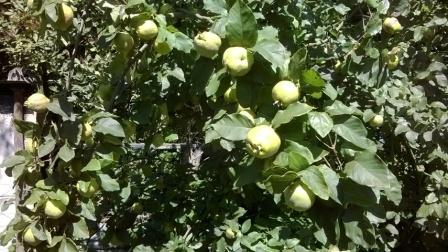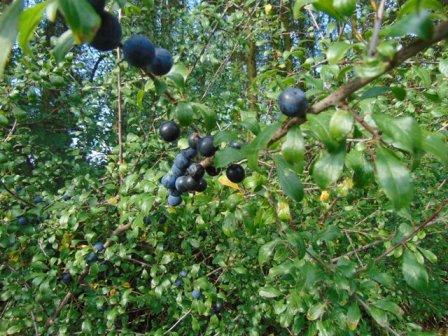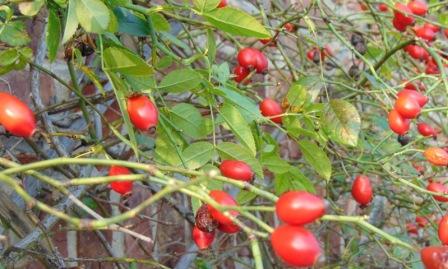Quince
 The quince (Cydonia oblonga) is a flowering plant in the rose family (Rosaceae). It's not a pear, but a bitter fruit, akin to the pear, apple or ash. The branched shrub with many shoots and root sprouts is 4 to 5 meters high.
The quince (Cydonia oblonga) is a flowering plant in the rose family (Rosaceae). It's not a pear, but a bitter fruit, akin to the pear, apple or ash. The branched shrub with many shoots and root sprouts is 4 to 5 meters high.
Quinces are almost impossible to eat raw. They are very hard because of the many stone cells with a hard side. The tannins and phenols tastes sour. Quinces are high in pectin and contain 10-14% sugar. They have a fluffy skin. But they are stewed, and processed into compote, delicious jams, marmalades, jellies, fruit juice, fruit pastes (diced similar to chocolates), cake, candied...
The word ’marmalade’(originally quince jam) comes from the Portuguese name for this fruit: marmelo.
You can keep quinces long. Put some in the house, they have a pleasant aroma. There are whole sets of beneficial medicinal effects awarded on the quince: diuretic, refreshing, stimulating, aid to cough and mucosal healing, tonic and recovery stimulating, astringent, appetite stimulant and digestive support, and supports the heart.
I often use the clear jelly in a cup of hot water to make quickly some yummy tea.
The (uncooked) kernels also are used.
Cover them with gin. If you shake regularly with the pot, a slime layer is formed on the seeds. That is perfect salve that softens some inconveniences very gentle. You can smear this glassy mucus on rough hands and feet, as it cools and makes the skin supple. It is an excellent remedy against skin fissures. You can also use it for bedsores. But the alcohol may excite. You can replace it with water or an infusion of lemon balm. As a result, the gel is a shorter shelf life. Gin gel keeps years.
If you’re out of gel, just pour some liquid again on the same kernels. After a few days you have new gel. You can safely leave the seeds in the pot.
Blackthorn or Sloe
 The blackthorn (Prunus spinosa) is a flowering plant in the rose family (Rosaceae). It is a native shrub that becomes 2-6 m high in our forest edges. The plant spreads by seeds and root sprouts. Because of its thorns, it is a suitable hedge plant. She can proliferate! The wood is very hard.
The blackthorn (Prunus spinosa) is a flowering plant in the rose family (Rosaceae). It is a native shrub that becomes 2-6 m high in our forest edges. The plant spreads by seeds and root sprouts. Because of its thorns, it is a suitable hedge plant. She can proliferate! The wood is very hard.
The genus Prunus is an old Latin word for plum tree. The species designation ’spinosa’ means prickly or thorny. Sloe comes from an old word for plum: sled, also recognizable in the Slavic word for plum, recognizable in Slivovitz.
Blackthorn flowers from March to April. The white sloe flowers can be used for tea.
There are fruits from August, but they are only good when they had some frost. The ripe berries are blue-black and about 1 to 1.5 cm.
The fruits are processed into jams, compotes, fruit juice, fruit wine and brandy.
The cherry plum (Prunus cerasifera, also ‘kroos’ (Dutch) or myrobalan) belongs to the rose family (Rosaceae) and was planted in Central Europe because of the early edible fruits. Possibly the cultivated plum (Prunus domestica) is a hybrid of this tree and the blackthorn (Prunus spinosa). Regional names are confusing and popularly (they are sometimes also called plum (Prunus insititia) and mirabelle).
Often early flowering cultivars (before blackthorn and plum) with freakish branches are green or 'purple' leaved (red-leaved: Prunus cerasifera ‘Nigra’) an used as an ornamental tree with sterile (not fruit-bearing) flowers.
The green to yellow or red, small fruits with a short stem are spherical. These early bloomers are sensitive to frost, and are therefore hardly ever grown anymore.
Medlar
 Mespilus comes from the Greek mesos (half /center) and pilos (sphere), and refers to the shape of the fruit: a hemisphere. The medlar (Mespilus germanica) is a flowering plant in the rose family (Rosaceae).
Mespilus comes from the Greek mesos (half /center) and pilos (sphere), and refers to the shape of the fruit: a hemisphere. The medlar (Mespilus germanica) is a flowering plant in the rose family (Rosaceae).
The shrub / tree can be about 4.5 m high, the wild form with branch thorns, the cultivated forms usually without thorns.
The medlar is related to the apple and pear, and is full of vitamin C. Previously, before the introduction of other fruits in Western Europe it was a very important fruit. The medlar is good for the stomach and digestion.
The medlar flowers in May and June with about 4 cm wide, creamy-white blossoms.
The small fruits are dry, hard and golden brown. They are ripe in October, but still unpalatable, mealy and bitter. After the first frosts they are soft and brown, and then they can be eaten. (You can also put the fruit a few days in the freezer.)
So beware picking in October or November, and save them with the top down two to three weeks in a cool place. She actually belongs to our winter food.
The fruit is ’hurt’(overripe, bruised, soft). By a fermentation process the color of green / white turns to dark brown and the flavor is typically sweet cloying. The fruit is mainly used in jelly, compote....
If the medlar is soft, it’s just to keep a few days. He can easily go moldy and rot really.
‘As rotten as a medlar ’therefore refers in fact to a special and specific delicacy.
Rosehip : see tea. Sea Buckthorn
Sea Buckthorn
Hippophae rhamnoides is a pioneer who takes nitrogen from the air, and it does well on poor soils. You can find these winter hardy (salt tolerant) hedge plant in coastal areas and along roads. The wood is suitable for canes.
The yellow-orange to brownish red, oval fruit is a sham berry, a nut in a fleshy husk.
The berries are close to the twig among thorns, and are therefore difficult to pick. Easier is it to cut the branches first, and then the berries (wear gloves.). Or freeze twigs, and then shake the berries.
The bush was formerly ’milked’: squeeze the berries on the bush and collect the juice in a bowl to sieve it later. You can make delicious jam, syrup, lemonade or wine. The sour berry is very rich in vitamins.
After frost starch can be changed into sugar and ferment, so birds that eat them sometimes flutter around drunk.
The highly oil-rich berry is also suitable for skin creams.
There are now also female, thornless varieties that give many berries. (The male specimens bear no fruit.)
Red fleshed apples
Early last century there have been many attempts to grow a red fleshed eating apple based on the purple, flat round Malus niedzwetskyana from the Caucasus. The first varieties were generally acid and small.
The American Albert Etter (1872-1950) crossbred the only then known red fleshed apple ’Surprise’ with other apples and developed about 30 red fleshed dessert apples. There was little interest. With his death also most of his work was lost. Some ancient wild trees are found in his neglected orchard and are now patented by a tree nursery.
In New Zealand red fleshed apples are developed with advanced genetic techniques.
Red fleshed apples have a high content of anthocyanin (red pigment) which is a strong antioxidant.
In October 2013 6,000 kg (Swiss) Red Love was sold through the Limburg (be) auction.
Some red fleshed apple varieties also have dark purple leaves and light purple flowers.
‘Niedzwetskyana', ’Red Devil',’Redlane', ’Dries', ’Pink Pearl', ’Pink Pearmain', ’Pink Christmas',...
So in a near future it will be possible to make also red apple juice and red wine from apples and red apple compote.
Apples floatbecause theycontain 25-30% air. (Pearsonly 5%.)
Thecoreof eachappleis edible. Theseedsalso. (They contain somecyanide, such as almonds. So you shouldnot eatmassseeds.) It doesnot make sensetoactuallydegrade the widestpart ofan edible fruittowaste.
